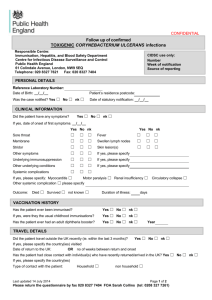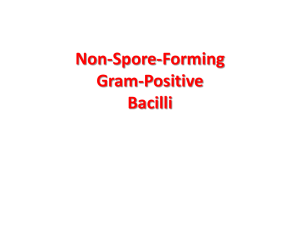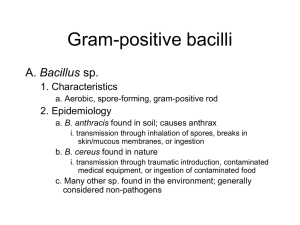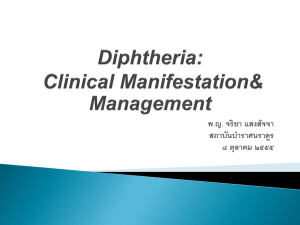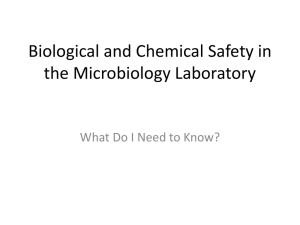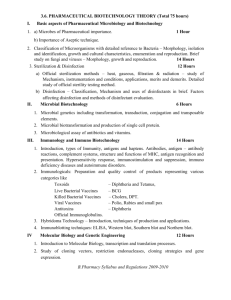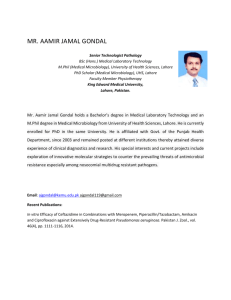ID 2i4.1 October 2014
advertisement
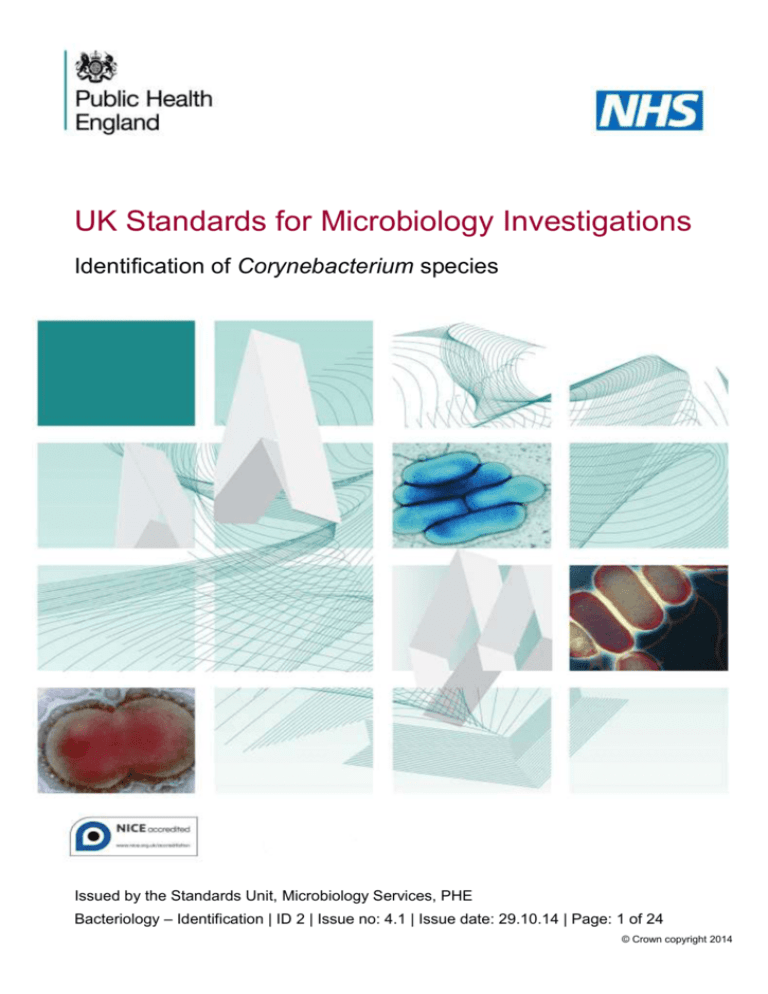
UK Standards for Microbiology Investigations Identification of Corynebacterium species Issued by the Standards Unit, Microbiology Services, PHE Bacteriology – Identification | ID 2 | Issue no: 4.1 | Issue date: 29.10.14 | Page: 1 of 24 © Crown copyright 2014 Identification of Corynebacterium species Acknowledgments UK Standards for Microbiology Investigations (SMIs) are developed under the auspices of Public Health England (PHE) working in partnership with the National Health Service (NHS), Public Health Wales and with the professional organisations whose logos are displayed below and listed on the website https://www.gov.uk/ukstandards-for-microbiology-investigations-smi-quality-and-consistency-in-clinicallaboratories. SMIs are developed, reviewed and revised by various working groups which are overseen by a steering committee (see https://www.gov.uk/government/groups/standards-for-microbiology-investigationssteering-committee). The contributions of many individuals in clinical, specialist and reference laboratories who have provided information and comments during the development of this document are acknowledged. We are grateful to the Medical Editors for editing the medical content. For further information please contact us at: Standards Unit Microbiology Services Public Health England 61 Colindale Avenue London NW9 5EQ E-mail: standards@phe.gov.uk Website: https://www.gov.uk/uk-standards-for-microbiology-investigations-smi-qualityand-consistency-in-clinical-laboratories UK Standards for Microbiology Investigations are produced in association with: Logos correct at time of publishing. Bacteriology – Identification | ID 2 | Issue no: 4.1 | Issue date: 29.10.14 | Page: 2 of 24 UK Standards for Microbiology Investigations | Issued by the Standards Unit, Public Health England Identification of Corynebacterium species Contents ACKNOWLEDGMENTS .......................................................................................................... 2 AMENDMENT TABLE ............................................................................................................. 4 UK STANDARDS FOR MICROBIOLOGY INVESTIGATIONS: SCOPE AND PURPOSE ....... 6 SCOPE OF DOCUMENT ......................................................................................................... 9 INTRODUCTION ..................................................................................................................... 9 TECHNICAL INFORMATION/LIMITATIONS ......................................................................... 10 1 SAFETY CONSIDERATIONS .................................................................................... 12 2 TARGET ORGANISMS .............................................................................................. 12 3 IDENTIFICATION ....................................................................................................... 12 4 IDENTIFICATION OF CORYNEBACTERIUM SPECIES............................................ 18 5 REPORTING .............................................................................................................. 19 6 REFERRALS.............................................................................................................. 20 7 NOTIFICATION TO PHE OR EQUIVALENT IN THE DEVOLVED ADMINISTRATIONS .................................................................................................. 21 REFERENCES ...................................................................................................................... 22 Bacteriology – Identification | ID 2 | Issue no: 4.1 | Issue date: 29.10.14 | Page: 3 of 24 UK Standards for Microbiology Investigations | Issued by the Standards Unit, Public Health England Identification of Corynebacterium species Amendment Table Each SMI method has an individual record of amendments. The current amendments are listed on this page. The amendment history is available from standards@phe.gov.uk. New or revised documents should be controlled within the laboratory in accordance with the local quality management system. Amendment No/Date. 7/29.10.14 Issue no. discarded. 4 Insert Issue no. 4.1 Section(s) involved Amendment Whole document. Hyperlinks updated to gov.uk. Page 2. Updated logos added. Identification. Updates have been done on 3.4 and 3.5 to reflect standards in practice. Subsection 3.5 has been updated to include the Rapid Molecular Typing Methods. Amendment No/Date. 6/18.06.14 Issue no. discarded. 3.2 Insert Issue no. 4 Section(s) involved Amendment Scope of document. The title of SMI document ID 3 referred to in the text has been updated. Taxonomy updated. Introduction. More information has been added to the Characteristics section. Removal of two sentences on PCR from this section. Section on Principles of Identification has been updated to reflect the four preliminary tests used in identification of Corynebacterium species. Technical Information/Limitations. Updated to include information regarding use of sheep blood agar media and variability of the nitrate test. Safety considerations. This section has been updated to include the laboratory - acquired infections as well as Bacteriology – Identification | ID 2 | Issue no: 4.1 | Issue date: 29.10.14 | Page: 4 of 24 UK Standards for Microbiology Investigations | Issued by the Standards Unit, Public Health England Identification of Corynebacterium species guidelines laid out by the DH Green book. Updates have been done on 3.3, 3.4 and 3.6 to reflect standards in practice. The table has also been updated with references and two more columns to include the catalase and pyrazinamidase tests. The footnote in the table has also been updated. Identification. - TP 36 Urease Test has been hyperlinked. - Variable test results for nitrate test in C. pseudotuberculosis have also been mentioned. - Referral of isolate to the Reference Laboratory has been updated. - References used for the table are listed in the footnote. Subsection 3.5 has been updated to include the Rapid Molecular Methods. Identification Flowchart. Reporting. Addition of flowchart for identification of Corynebacterium species has been developed for guidance. Subsections 5.1, 5.2, 5.4, 5.5 and 5.6 have been updated to reflect reporting practice. The webpage link in section 5.4 and 5.5 has been removed as it is not accessible. Referral. The address of the Reference Laboratory has been updated. Whole document. Document presented in a new format. References. Some references updated. Bacteriology – Identification | ID 2 | Issue no: 4.1 | Issue date: 29.10.14 | Page: 5 of 24 UK Standards for Microbiology Investigations | Issued by the Standards Unit, Public Health England Identification of Corynebacterium species UK Standards for Microbiology Investigations: Scope and Purpose Users of SMIs SMIs are primarily intended as a general resource for practising professionals operating in the field of laboratory medicine and infection specialties in the UK. SMIs provide clinicians with information about the available test repertoire and the standard of laboratory services they should expect for the investigation of infection in their patients, as well as providing information that aids the electronic ordering of appropriate tests. SMIs provide commissioners of healthcare services with the appropriateness and standard of microbiology investigations they should be seeking as part of the clinical and public health care package for their population. Background to SMIs SMIs comprise a collection of recommended algorithms and procedures covering all stages of the investigative process in microbiology from the pre-analytical (clinical syndrome) stage to the analytical (laboratory testing) and post analytical (result interpretation and reporting) stages. Syndromic algorithms are supported by more detailed documents containing advice on the investigation of specific diseases and infections. Guidance notes cover the clinical background, differential diagnosis, and appropriate investigation of particular clinical conditions. Quality guidance notes describe laboratory processes which underpin quality, for example assay validation. Standardisation of the diagnostic process through the application of SMIs helps to assure the equivalence of investigation strategies in different laboratories across the UK and is essential for public health surveillance, research and development activities. Equal Partnership Working SMIs are developed in equal partnership with PHE, NHS, Royal College of Pathologists and professional societies. The list of participating societies may be found at https://www.gov.uk/uk-standards-formicrobiology-investigations-smi-quality-and-consistency-in-clinical-laboratories. Inclusion of a logo in an SMI indicates participation of the society in equal partnership and support for the objectives and process of preparing SMIs. Nominees of professional societies are members of the Steering Committee and Working Groups which develop SMIs. The views of nominees cannot be rigorously representative of the members of their nominating organisations nor the corporate views of their organisations. Nominees act as a conduit for two way reporting and dialogue. Representative views are sought through the consultation process. SMIs are developed, reviewed and updated through a wide consultation process. Microbiology is used as a generic term to include the two GMC-recognised specialties of Medical Microbiology (which includes Bacteriology, Mycology and Parasitology) and Medical Virology. Bacteriology – Identification | ID 2 | Issue no: 4.1 | Issue date: 29.10.14 | Page: 6 of 24 UK Standards for Microbiology Investigations | Issued by the Standards Unit, Public Health England Identification of Corynebacterium species Quality Assurance NICE has accredited the process used by the SMI Working Groups to produce SMIs. The accreditation is applicable to all guidance produced since October 2009. The process for the development of SMIs is certified to ISO 9001:2008. SMIs represent a good standard of practice to which all clinical and public health microbiology laboratories in the UK are expected to work. SMIs are NICE accredited and represent neither minimum standards of practice nor the highest level of complex laboratory investigation possible. In using SMIs, laboratories should take account of local requirements and undertake additional investigations where appropriate. SMIs help laboratories to meet accreditation requirements by promoting high quality practices which are auditable. SMIs also provide a reference point for method development. The performance of SMIs depends on competent staff and appropriate quality reagents and equipment. Laboratories should ensure that all commercial and in-house tests have been validated and shown to be fit for purpose. Laboratories should participate in external quality assessment schemes and undertake relevant internal quality control procedures. Patient and Public Involvement The SMI Working Groups are committed to patient and public involvement in the development of SMIs. By involving the public, health professionals, scientists and voluntary organisations the resulting SMI will be robust and meet the needs of the user. An opportunity is given to members of the public to contribute to consultations through our open access website. Information Governance and Equality PHE is a Caldicott compliant organisation. It seeks to take every possible precaution to prevent unauthorised disclosure of patient details and to ensure that patient-related records are kept under secure conditions. The development of SMIs are subject to PHE Equality objectives https://www.gov.uk/government/organisations/public-health-england/about/equalityand-diversity. The SMI Working Groups are committed to achieving the equality objectives by effective consultation with members of the public, partners, stakeholders and specialist interest groups. Legal Statement Whilst every care has been taken in the preparation of SMIs, PHE and any supporting organisation, shall, to the greatest extent possible under any applicable law, exclude liability for all losses, costs, claims, damages or expenses arising out of or connected with the use of an SMI or any information contained therein. If alterations are made to an SMI, it must be made clear where and by whom such changes have been made. The evidence base and microbial taxonomy for the SMI is as complete as possible at the time of issue. Any omissions and new material will be considered at the next review. These standards can only be superseded by revisions of the standard, legislative action, or by NICE accredited guidance. SMIs are Crown copyright which should be acknowledged where appropriate. Bacteriology – Identification | ID 2 | Issue no: 4.1 | Issue date: 29.10.14 | Page: 7 of 24 UK Standards for Microbiology Investigations | Issued by the Standards Unit, Public Health England Identification of Corynebacterium species Suggested Citation for this Document Public Health England. (2014). Identification of Corynebacterium species. UK Standards for Microbiology Investigations. ID 2 Issue 4.1. https://www.gov.uk/ukstandards-for-microbiology-investigations-smi-quality-and-consistency-in-clinicallaboratories Bacteriology – Identification | ID 2 | Issue no: 4.1 | Issue date: 29.10.14 | Page: 8 of 24 UK Standards for Microbiology Investigations | Issued by the Standards Unit, Public Health England Identification of Corynebacterium species Scope of Document This SMI describes the identification to species level of Corynebacterium diphtheriae, Corynebacterium ulcerans and Corynebacterium pseudotuberculosis isolated from throat, skin and other sites. These organisms may be isolated from suspected cases of classical diphtheria, cutaneous diphtheria and very rarely from other clinical infections such as pharyngitis or chronic skin infections. The importance of toxin production by this species in the pathogenesis of disease is emphasised. The document also describes the identification of non-toxigenic species, Corynebacterium jeikeium, Corynebacterium striatum and other clinically significant species. Arcanobacterium haemolyticum, formerly known as Corynebacterium haemolyticum is covered in ID 3 - Identification of Listeria species and other NonSporing Gram Positive Rods (except Corynebacterium). This SMI covers four tests for the preliminary identification of pathogenic Corynebacterium species and recommends that the organisms be sent to the Reference Laboratory for confirmation of identification and toxin testing if required. This SMI should be used in conjunction with other SMIs. Introduction Taxonomy1,2 There are currently 112 species and 11 subspecies in this genus3. All Corynebacterium species that have genetic and chemotaxonomic features inconsistent with those currently attributed to this genus have been reassigned to other genera. Conversely, relevant taxa assigned to other genera and those with Corynebacterium-like features, have been added to the genus4. Of these, 55 species are occasional or extremely rare causes of infection in humans or are transmitted to humans by zoonotic contact, with the remaining species having been recovered solely from animals or birds, the environment, water, foodstuffs or synthetic materials. The potentially toxigenic corynebacteria comprise C. diphtheriae, C. pseudotuberculosis and C. ulcerans. C. diphtheriae consists of four biovars: gravis, mitis, intermedius and belfanti. Characteristics Corynebacterium species are Gram positive non-motile rods, often with clubbed ends, occurring singly or in pairs. Some cells may stain unevenly giving a beaded appearance. Their size is between 2-6µm in length and 0.5µm in diameter. They group together in a characteristic way, which has been described as the form of a "V", "palisades", or "Chinese letters". Metachromatic granules are usually present representing stored phosphate regions. They are aerobic or facultatively anaerobic and exhibit a fermentative metabolism (carbohydrates to lactic acid) under certain conditions. They are fastidious organisms, growing slowly even on enriched medium. Agar containing blood and potassium tellurite, such as Hoyle's tellurite medium, serves as a selective and differential medium. On blood agar, they form small greyish colonies with a granular appearance, mostly translucent, but with opaque centres, convex, with continuous borders. Their optimum growth temperature is 37°C. Bacteriology – Identification | ID 2 | Issue no: 4.1 | Issue date: 29.10.14 | Page: 9 of 24 UK Standards for Microbiology Investigations | Issued by the Standards Unit, Public Health England Identification of Corynebacterium species C. diphtheriae grows as pinpoint grey/black colonies on Hoyle’s tellurite agar in 1618hr and produces characteristic colonies after 48hr. Isolates of potentially toxigenic Corynebacterium species will also grow on blood agar. Colonial morphology varies among the species. C. ulcerans and C. pseudotuberculosis colonies may be slightly β-haemolytic on blood agar. C. diphtheriae, C. ulcerans and C. pseudotuberculosis are facultatively anaerobic, non-sporing, non-capsulated and non-acid-fast. These organisms are non-motile and catalase positive. C. ulcerans and C. pseudotuberculosis are both urease positive which may be used to distinguish them presumptively from C. diphtheriae. Strains of these species can all harbour the phage borne diphtheria tox gene, which is required for the production of toxin5. Toxigenic strains may cause diphtheria or diphtheria-like illness. Possible toxigenic strains of Corynebacterium species should be referred to the Reference Laboratory for detection of toxin production as soon as possible. Non toxigenic strains of corynebacteria eg C. ulcerans, C. jeikeium, C. striatum and non-toxigenic C. diphtheriae are also known to cause infections in humans including pulmonary infection, leukaemia and endocarditis. Both C. jeikeium and C. striatum are non-haemolytic, urease negative and catalase positive6. Principles of Identification Isolates from primary culture are identified by colonial appearance, Gram stain, and four preliminary tests (this includes nitrate, urease, catalase and pyrazinamidase tests) which permit the presumptive identification of the potentially toxigenic Corynebacterium species within 4hr. Additional identification may be made using a commercial identification kit in conjunction with toxin testing. It is advisable that suspected toxigenic cultures are sent promptly to the Streptococcus and Diphtheria Reference Unit (SDRU) for confirmation of identification and toxigenicity testing. Use of Albert’s stain is not recommended in this SMI, as metachromatic granules are not specific to C. diphtheriae or any of the potentially toxigenic corynebacteria. The interpretation of the clinical significance of Corynebacterium isolated from microbiological samples can be problematic. Corynebacterium isolated as a predominant organism from a specimen from a normally sterile site, wound, abscess or purulent sputum, from more than one blood culture set or present at ≥104 cfu/mL in a pure culture from urine should be considered for identification to species level. The clinical significance is strengthened when isolating Corynebacterium species from multiple samples or when they are seen in a Gram stained smear as the predominant organism or associated with a significant leucocyte response7. Technical Information/Limitations Corynebacterium pseudotuberculosis C. pseudotuberculosis can give a variable nitrate test result. This is because it consists of two biovars: biovar equi (from horses or cattle) that reduces nitrate and the biovar ovis (from sheep or goats) that fails to do so6. Bacteriology – Identification | ID 2 | Issue no: 4.1 | Issue date: 29.10.14 | Page: 10 of 24 UK Standards for Microbiology Investigations | Issued by the Standards Unit, Public Health England Identification of Corynebacterium species Agar Media The classic colonial morphology apparently develops better on media containing sheep blood rather than horse in some Corynebacterium species. For example, the degree of haemolysis in Arcanobacterium haemolyticum, formerly known as Corynebacterium haemolyticum is far greater on sheep blood agar plate than most other corynebacteria8. Bacteriology – Identification | ID 2 | Issue no: 4.1 | Issue date: 29.10.14 | Page: 11 of 24 UK Standards for Microbiology Investigations | Issued by the Standards Unit, Public Health England Identification of Corynebacterium species 1 Safety Considerations9-25 C. diphtheriae, C. ulcerans and C. pseudotubercolosis are Hazard Group 2 organisms, and in some cases the nature of the work may dictate full Containment Level 3 conditions. All laboratories should handle specimens as if potentially high risk. All suspected isolates of potentially toxigenic corynebacteria should always be handled in a microbiological safety cabinet. For the urease test, a urea slope is considered safer than a liquid medium. C. diphtheriae and C. ulcerans cause severe and sometimes fatal diseases. Laboratory acquired infections have been reported26,27. The organism infects primarily by the respiratory route. Vaccination against diphtheria is available; guidance is given in the DH Green Book28. In addition, all staff that may be exposed to diphtheria in the course of their work should be protected by immunisation and exceptions to this recommendation are those who have had a booster within the last 10 years or have had an adverse reaction to immunisation28,29. Diphtheria antitoxin for the treatment of clinical cases is distributed by PHE Immunisation Department and should be given without waiting for bacteriological confirmation. Refer to current guidance on the safe handling of all Hazard Group 2 organisms documented in this SMI. Laboratory procedures that give rise to infectious aerosols must be conducted in a microbiological safety cabinet17. The above guidance should be supplemented with local COSHH and risk assessments. Compliance with postal and transport regulations is essential. 2 Target Organisms Corynebacterium species which are potentially toxigenic1 Corynebacterium diphtheriae var belfanti, Corynebacterium diphtheriae var gravis, Corynebacterium diphtheriae var intermedius, Corynebacterium diphtheriae var mitis, Corynebacterium pseudotuberculosis, Corynebacterium ulcerans Corynebacterium species which are non-toxigenic6 Corynebacterium diphtheriae, Corynebacterium pseudotuberculosis, Corynebacterium ulcerans, Corynebacterium jeikium, Corynebacterium striatum Other Corynebacterium species have been known to cause human infection2. 3 Identification 3.1 Microscopic Appearance Gram stain (TP 39 - Staining Procedures) Gram positive rods, pleomorphic, slightly curved with tapered or clubbed ends. Bacteriology – Identification | ID 2 | Issue no: 4.1 | Issue date: 29.10.14 | Page: 12 of 24 UK Standards for Microbiology Investigations | Issued by the Standards Unit, Public Health England Identification of Corynebacterium species Cells may occur singly or in pairs, often in a “V” formation (forming “Chinese letters”). Cells usually stain weakly and unevenly giving a beaded appearance. 3.2 Primary Isolation Media Blood agar - skin swabs incubated in 5-10% CO2 at 35-37°C for 40-48hr and throat swabs incubated anaerobically at 35-37°C for 16-24hr. β-haemolytic streptococci may also be present, particularly in throat swabs. Hoyle’s tellurite agar incubated in air at 35-37°C for 16-48hr. 3.3 Colonial Appearance Appearance varies among species on blood agar plates. For more information, refer to the table in Section 3.4 Test Procedures below. 3.4 Test Procedures 3.4.1 Biochemical tests Rapid (4hr) tests should be performed for urease, pyrazinamidase, catalase and nitrate reduction. Catalase test (TP 8 - Catalase Test) All potentially toxigenic corynebacteria are catalase positive and for non-toxigenic Corynebacterium species, the catalase test results are varied. Pyrazinamidase test All potentially toxigenic corynebacteria (C. diphtheriae, C. ulcerans and C. pseudotuberculosis) are pyrazinamidase negative while other corynebacteria are positive. Urease test (TP 36 - Urease Test) The urease test is used to determine the ability of an organism to split urea, through the production of the enzyme urease. C. ulcerans and C. pseudotuberculosis are urease positive. Nitrate Reduction test - see table below Biochemical tests† Culture media Strain Hoyle’s tellurite agar Blood agar Nitrate Urease* Catalase Pyrazinamidase C. diphtheriae biotype biovar gravis30 dull, grey/black, opaque colonies, 1.5-2.0mm in diameter, matt surface, friable, tending to break into small segments when touched with a straight wire Non haemolytic Positive Negative Positive Negative C. diphtheriae biotype biovar mitis30 grey/black, opaque colonies, 1.5 - 2.0mm in diameter, entire edge and glossy smooth surface; size variation is common colonies exhibit a small zone of haemolysis Positive Negative Positive Negative C. diphtheriae small, grey/black, shiny surface, discrete, colonies exhibit a small Positive Negative Positive Negative Bacteriology – Identification | ID 2 | Issue no: 4.1 | Issue date: 29.10.14 | Page: 13 of 24 UK Standards for Microbiology Investigations | Issued by the Standards Unit, Public Health England Identification of Corynebacterium species translucent colonies, 0.51.0mm in diameter zone of haemolysis C. diphtheriae biotype biovar belfanti30 grey/black, opaque colonies, 1.5-2.0mm in diameter, entire edge and glossy smooth surface; size variation is common colonies exhibit a small zone of haemolysis Negative Negative Positive Negative C. ulcerans30 grey/black, very dry opaque colonies colonies exhibit a small zone of haemolysis Negative Positive Positive Negative grey/black, very dry opaque colonies colonies exhibit a small zone of haemolysis Positive/ Negative Positive Positive Negative Negative Positive Positive Negative Positive Positive biotype biovar intermedius 30 C. pseudotuberculosis 1,6,31 Nonhaemolytic C. striatum1,2,31 grey/black, colonies white moist smooth colonies > 2mm after 24hr Positive/ Negative Non haemolytic C. jeikeium † grey/black, colonies grey/white low convex colonies Negative Refer to TP 36 - Urease Test *If results of these 4hr tests indicate Corynebacterium species, immediately inform medical microbiologist and refer isolate to the Reference Laboratory. C. xerosis can be used as a positive control for this test. If these preliminary tests do not indicate Corynebacterium species then consider further identification tests if clinically indicated. Result for the nitrate test can be variable for C. pseudotuberculosis. This is because it consists of two biovars: biovar equi (from horses or cattle) that reduces nitrate and the biovar ovis (from sheep or goats) that fails to do so. Use commercial identification kit and refer isolate to the Reference Laboratory if clinically indicated. Note: Fresh culture of control organism is advisable. These test results are consistent with taxonomy from widely published systems 1,2,6,30,31. It is important that a preliminary identification of possible colonies of C. diphtheriae or other potentially toxigenic Corynebacterium species is made as rapidly as possible with the use of 4hr tests. The preliminary tests provide an indication of the likely presence or absence of C. diphtheriae, C. ulcerans or C. pseudotuberculosis. The results should be considered together with the clinical details. All suspected isolates of C. diphtheriae or other potentially toxigenic Corynebacterium species should be sub-cultured to a blood agar plate for purity and to a blood agar slope (preferably) or Loeffler’s media (for possible referral to the Reference Laboratory) at the time that the tests are set up. Bacteriology – Identification | ID 2 | Issue no: 4.1 | Issue date: 29.10.14 | Page: 14 of 24 UK Standards for Microbiology Investigations | Issued by the Standards Unit, Public Health England Identification of Corynebacterium species 3.4.2 Commercial Identification Systems Laboratories should follow manufacturer’s instructions and rapid tests and kits should be validated and be shown to be fit for purpose prior to use. 3.4.3 Matrix-Assisted Laser Desorption Ionization– Time of Flight Mass Spectrometry (MALDI-TOF) MALDI-TOF MS analysis is a routinely used tool in many microbiology laboratories, whereby proteins liberated from bacteria are ionized and detected by a mass spectrometer (MS), the spectrum is analysed, and its pattern is compared to entries found in a database, giving rise to a degree of match32. This technology is touted as being revolutionary, because it does not require extensive training or expertise in mass spectrometry or chemistry to use. The cost for consumables is described as relatively low per sample, excluding the cost of the MALDI-TOF instrument4. MALDI-TOF MS has been used successfully to identify potentially toxigenic Corynebacterium species at the species level in clinical isolates within 15 minutes33. Thus, this technology could be used as a rapid screening method helping to decide whether suspicious colonies should be analysed for the presence of the tox gene by real-time PCR. MALDI-TOF can also discriminate Corynebacterium aurimucosum from Corynebacterium minutissimum, two closely related Corynebacterium species previously considered difficult to differentiate34. 3.4.4 Nucleic Acid Amplification Tests (NAATs) PCR is usually considered to be a good method for bacterial detection as it is simple, rapid, sensitive and specific. The basis for PCR diagnostic applications in microbiology is the detection of infectious agents and the discrimination of non-pathogenic from pathogenic strains by virtue of specific genes. However, it does have limitations. Although the 16S rRNA gene is generally targeted for the design of species-specific PCR primers for identification, designing primers is difficult when the sequences of the homologous genes have high similarity. PCR for Corynebacterium diphtheriae is rapid and can be completed within 4hr of receipt of the strain, although toxin production must always be verified by the phenotypic test for toxigenicity35. A PCR directed at the A subunit of the diphtheria toxin gene can also be used to detect the tox gene, the structural gene for diphtheria toxin, although it does not confirm toxin production29. Molecular characterization based on polymerase chain reaction (PCR) of some of the non-toxigenic strains has demonstrated that the bacteria often contain functional dtxR proteins, which could potentially produce toxin36. 3.5 Further Identification Rapid Molecular Methods A variety of rapid typing methods have been developed for isolates from clinical samples; these include molecular techniques such as Amplified Fragment Length Polymorphism (AFLP), 16S rRNA gene (rDNA) sequence analysis, Multi-locus Sequence typing (MLST) and Whole Genome Sequencing. All of these approaches enable subtyping of unrelated strains, but do so with different accuracy, discriminatory power, and reproducibility. Bacteriology – Identification | ID 2 | Issue no: 4.1 | Issue date: 29.10.14 | Page: 15 of 24 UK Standards for Microbiology Investigations | Issued by the Standards Unit, Public Health England Identification of Corynebacterium species However, some of these methods remain accessible to reference laboratories only and are difficult to implement for routine bacterial identification in clinical laboratories. Whole Genome Sequencing (WGS) Whole genome sequencing (also known as full genome sequencing, complete genome sequencing, or entire genome sequencing), is a laboratory process that determines the complete DNA sequence of an organism's genome at a single time. This entails sequencing all of an organism's chromosomal DNA as well as DNA contained in the mitochondria. A number of Corynebacterium species have had complete genomes sequenced4. Genome sequences are available in the public database for C. glutamicum, C. efficiens, C. diphtheriae C. jeikeium, C. pseudotuberculosis and C. ulcerans. This has also aided in the identification of Corynebacterium species. Multi-locus Sequence Typing (MLST) MLST measures the DNA sequence variations in a set of housekeeping genes directly and characterizes strains by their unique allelic profiles. The principle of MLST is simple: the technique involves PCR amplification followed by DNA sequencing. Nucleotide differences between strains can be checked at a variable number of genes depending on the degree of discrimination desired. The technique is highly discriminatory, as it detects all the nucleotide polymorphisms within a gene rather than just those non-synonymous changes that alter the electrophoretic mobility of the protein product. One of the advantages of MLST over other molecular typing methods is that sequence data are portable between laboratories and have led to the creation of global databases that allow for exchange of molecular typing data via the internet37. MLST has been used successfully for characterisation of Corynebacterium diphtheriae as has been evaluated in various reports and it has also been found to provide a good understanding of the diversity of the pathogen38-40. Amplified Fragment Length Polymorphism (AFLP) Amplified Fragment Length Polymorphism is a high-resolution whole genome methodology used as a tool for rapid and cost-effective analysis of genetic diversity within bacterial genomes. It is useful for a broad range of applications such as identification and subtyping of microorganisms from clinical samples, for identification of outbreak genotypes, for studies of micro and macro-variation, and for population genetics41,42. Amplified Fragment Length Polymorphism (AFLP), a gel-based method can also be used for further identification and has been successful in the discrimination and differentiation of C. diphtheriae isolates. This has been evaluated as a quicker, more affordable method to ribotyping (which is the current gold standard for typing of C. diphtheriae. This method is more adaptable especially in laboratories that have limited funding and equipment43,44. 16S rRNA gene (rDNA) sequence analysis A genotypic identification method, 16S rRNA gene sequencing is used for phylogenetic studies and has subsequently been found to be capable of re-classifying bacteria into completely new species, or even genera. It has also been used to describe new species that have never been successfully cultured. Bacteriology – Identification | ID 2 | Issue no: 4.1 | Issue date: 29.10.14 | Page: 16 of 24 UK Standards for Microbiology Investigations | Issued by the Standards Unit, Public Health England Identification of Corynebacterium species The use of molecular genetic methods such as 16S rRNA gene (rDNA) sequence analysis has facilitated a much tighter circumscription of the genus Corynebacterium, and the availability of comparative 16S rRNA gene sequence data with improved phenotypic data has resulted in much improved and more reliable species identification; however, rpoB gene sequences are used as they are more polymorphic than the 16S rDNA and can ensure reliable phylogenetic studies34,45. The only drawback with using the rpoB gene sequencing is that it is a time-consuming process which requires training staff to a competent level33. 3.6 Storage and Referral Refer the presumptive C. diphtheriae, C. ulcerans or C. pseudotuberculosis isolate on a Loeffler or blood agar slope immediately to the Reference Laboratory. Bacteriology – Identification | ID 2 | Issue no: 4.1 | Issue date: 29.10.14 | Page: 17 of 24 UK Standards for Microbiology Investigations | Issued by the Standards Unit, Public Health England Identification of Corynebacterium species 4 Identification of Corynebacterium species Clinical Specimen Screening, diagnosis/investigation of cases, contacts/carriers Blood agar- skin swabs incubated in 5-10% CO2 at 35-37C for 40-48hr and throat swabs incubated anaerobically at 35-37C for 16-24hr. Tellurite agar – incubated in air at 35-37°C for 16-46hr. Grey/black colonies Gram stain : Gram positive rods Nitrate 4hr Catalase 4hr Blood agar Pyrazinamidase 4hr Pure culture Urease 4hr Positive Negative Positive Negative Positive Negative Positive Negative C. diphtheriae var gravis C. diphtheriae var mitis C. diphtheriae var intermedius C. striatum C. pseudotuberculoisis var equi C. diphtheriae var belfanti C. ulcerans C. pseudotuberculoisis var ovis C. striatum C. jeikium All Corynebacterium sp Gardnerella vaginalis (formerly known as Corynebacterium vaginalis) C. striatum C. jeikium C. diphtheriae C. pseudotuberculoisis C. ulcerans C. ulcerans C. pseudotuberculoisis C. diphtheriae var mitis C. diphtheriae var gravis C. diphtheriae var intermedius C. diphtheriae var belfanti C. striatum C. jeikium For further identification, if clinically indicated, refer to the Reference Laboratory Bacteriology – Identification | ID 2 | Issue no: 4.1 | Issue date: 29.10.14 | Page: 18 of 24 UK Standards for Microbiology Investigations | Issued by the Standards Unit, Public Health England Identification of Corynebacterium species 5 Reporting 5.1 Presumptive Identification Presumptive identification may be made if appropriate growth characteristics, colonial appearance, Gram stain of the culture, 4hr test results and rapid methods are demonstrated. 5.2 Confirmation of Identification Confirmation of identification and toxigenicity are undertaken only by the Respiratory and Vaccine Preventable Bacteria Reference Unit (RVPBRU) PHE Colindale. 5.3 Medical Microbiologist Inform the medical microbiologist of presumptive and confirmed C. diphtheriae, C. ulcerans or C. pseudotuberculosis species. The medical microbiologist should also be informed if the request bears relevant information eg: Suspected case of contact with diphtheria or foreign travel Membranous/Pseudomembranous tonsillitis Ulcerating skin lesions acquired overseas. The medical microbiologist should be aware of possible factors from overseas protocols that could influence results Any of the above, with neurological or cardiological manifestations History of farming or veterinary work Any foreign travel to a high risk area, particularly Indian subcontinent, SouthEast Asia, Africa, South America, former Soviet States and Eastern Europe For presumptive and confirmed non-toxigenic Corynebacterium species the medical microbiologist should be informed when the request bears relevant information eg: Cases of suspected endocarditis associated with appropriate specimen Infection of indwelling medical devices (prosthetic valves, pacemakers, peritoneal and vascular catheters, CSF shunts) History of substance abuse, alcoholism, immunodeficiency or other serious underlying disorder such as cancer, or patients receiving treatment for cancer, inducing neutropenia and/or mucositis Follow local protocols for reporting to the clinician. 5.4 CCDC Refer to local Memorandum of Understanding. 5.5 Public Health England46 Refer to current guidelines on CIDSC and COSURV reporting. As diphtheria is a notifiable disease in the UK, for public health management of cases, contacts and outbreaks, all suspected cases should be notified immediately to the local Public Health England Centres. Bacteriology – Identification | ID 2 | Issue no: 4.1 | Issue date: 29.10.14 | Page: 19 of 24 UK Standards for Microbiology Investigations | Issued by the Standards Unit, Public Health England Identification of Corynebacterium species All clinically significant isolates should be notified by the diagnostic laboratories to ensure urgent initiation of proper procedures and all such isolates should be referred to the national reference laboratory for toxigenicity testing. 5.6 Infection Prevention and Control Teams Inform the infection prevention and control team of presumptive and confirmed isolates of C. diphtheriae according to local protocols. 6 Referrals 6.1 Reference Laboratory Contact appropriate devolved nation reference laboratory for information on the tests available, turnaround times, transport procedure and any other requirements for sample submission: Potentially toxigenic corynebacteria (C. diphtheriae, C. ulcerans, C. pseudotuberculosis) Streptococcus and Diphtheria Reference Section WHO Global Collaborating Centre for Streptococcal and Diphtheria Infections Respiratory and Vaccine Preventable Bacteria Reference Unit Microbiology Services Public Health England 61 Colindale Avenue London NW9 5EQ https://www.gov.uk/rvpbru-reference-and-diagnostic-services Other Corynebacterium species Antimicrobial Resistance and Healthcare Associated Infections Reference Unit (AMRHAI) Microbiology Services Public Health England 61 Colindale Avenue London NW9 5EQ https://www.gov.uk/amrhai-reference-unit-reference-and-diagnostic-services Contact PHE’s main switchboard: Tel. +44 (0) 20 8200 4400 England and Wales https://www.gov.uk/specialist-and-reference-microbiology-laboratory-tests-andservices Scotland http://www.hps.scot.nhs.uk/reflab/index.aspx Northern Ireland http://www.belfasttrust.hscni.net/Laboratory-MortuaryServices.htm Bacteriology – Identification | ID 2 | Issue no: 4.1 | Issue date: 29.10.14 | Page: 20 of 24 UK Standards for Microbiology Investigations | Issued by the Standards Unit, Public Health England Identification of Corynebacterium species 7 Notification to PHE46,47 or Equivalent in the Devolved Administrations48-51 The Health Protection (Notification) regulations 2010 require diagnostic laboratories to notify Public Health England (PHE) when they identify the causative agents that are listed in Schedule 2 of the Regulations. Notifications must be provided in writing, on paper or electronically, within seven days. Urgent cases should be notified orally and as soon as possible, recommended within 24 hours. These should be followed up by written notification within seven days. For the purposes of the Notification Regulations, the recipient of laboratory notifications is the local PHE Health Protection Team. If a case has already been notified by a registered medical practitioner, the diagnostic laboratory is still required to notify the case if they identify any evidence of an infection caused by a notifiable causative agent. Notification under the Health Protection (Notification) Regulations 2010 does not replace voluntary reporting to PHE. The vast majority of NHS laboratories voluntarily report a wide range of laboratory diagnoses of causative agents to PHE and many PHE Health protection Teams have agreements with local laboratories for urgent reporting of some infections. This should continue. Note: The Health Protection Legislation Guidance (2010) includes reporting of Human Immunodeficiency Virus (HIV) & Sexually Transmitted Infections (STIs), Healthcare Associated Infections (HCAIs) and Creutzfeldt–Jakob disease (CJD) under ‘Notification Duties of Registered Medical Practitioners’: it is not noted under ‘Notification Duties of Diagnostic Laboratories’. https://www.gov.uk/government/organisations/public-health-england/about/ourgovernance#health-protection-regulations-2010 Other arrangements exist in Scotland48,49, Wales50 and Northern Ireland51. Bacteriology – Identification | ID 2 | Issue no: 4.1 | Issue date: 29.10.14 | Page: 21 of 24 UK Standards for Microbiology Investigations | Issued by the Standards Unit, Public Health England Identification of Corynebacterium species References 1. Funke G, von Graevenitz A, Clarridge JE, III, Bernard KA. Clinical microbiology of coryneform bacteria. Clin Microbiol Rev 1997;10:125-59. 2. Clarridge JE, Weissfeld AS. Corynebacterial Infections. In: Wentworth BB, editor. Diagnostic Procedures for Bacterial Infections. 7th ed. Washington DC: American Public Health Association; 1987. p. 213-32. 3. Euzeby,JP. List of Prokaryotic names with Standing in Nomenclature - Genus Corynebacterium. 2013. 4. Bernard K. The genus corynebacterium and other medically relevant coryneform-like bacteria. J Clin Microbiol 2012;50:3152-8. 5. Ryan KJ. Corynebacterium, Listeria, and Bacillus. In: Ryan KJRCG, editor. Sherris Medical Microbiology: An Introduction to Infectious Diseases. 4 ed. USA: MCGraw Hill: 2004. p. 297-308. 6. Coyle MB, Lipsky BA. Coryneform bacteria in infectious diseases: clinical and laboratory aspects. Clin Microbiol Rev 1990;3:227-46. 7. Efstratiou A, George RC. Laboratory guidelines for the diagnosis of infections caused by Corynebacterium diphtheriae and C. ulcerans. World Health Organization. Commun Dis Public Health 1999;2:250-7. 8. Koneman EW, Allen SD, Janda WM, et al. The Aerobic Gram- Positive Bacilli. Color Atlas and Textbook of Diagnostic Microbiology. 5th ed. Philadelphia: Lippincott Williams and Wikins; 1997. p. 651-708. 9. European Parliament. UK Standards for Microbiology Investigations (SMIs) use the term "CE marked leak proof container" to describe containers bearing the CE marking used for the collection and transport of clinical specimens. The requirements for specimen containers are given in the EU in vitro Diagnostic Medical Devices Directive (98/79/EC Annex 1 B 2.1) which states: "The design must allow easy handling and, where necessary, reduce as far as possible contamination of, and leakage from, the device during use and, in the case of specimen receptacles, the risk of contamination of the specimen. The manufacturing processes must be appropriate for these purposes". 10. Official Journal of the European Communities. Directive 98/79/EC of the European Parliament and of the Council of 27 October 1998 on in vitro diagnostic medical devices. 7-12-1998. p. 1-37. 11. Health and Safety Executive. Safe use of pneumatic air tube transport systems for pathology specimens. 9/99. 12. Department for transport. Transport of Infectious Substances, 2011 Revision 5. 2011. 13. World Health Organization. Guidance on regulations for the Transport of Infectious Substances 2013-2014. 2012. 14. Home Office. Anti-terrorism, Crime and Security Act. 2001 (as amended). 15. Advisory Committee on Dangerous Pathogens. The Approved List of Biological Agents. Health and Safety Executive. 2013. p. 1-32 16. Advisory Committee on Dangerous Pathogens. Infections at work: Controlling the risks. Her Majesty's Stationery Office. 2003. Bacteriology – Identification | ID 2 | Issue no: 4.1 | Issue date: 29.10.14 | Page: 22 of 24 UK Standards for Microbiology Investigations | Issued by the Standards Unit, Public Health England Identification of Corynebacterium species 17. Advisory Committee on Dangerous Pathogens. Biological agents: Managing the risks in laboratories and healthcare premises. Health and Safety Executive. 2005. 18. Advisory Committee on Dangerous Pathogens. Biological Agents: Managing the Risks in Laboratories and Healthcare Premises. Appendix 1.2 Transport of Infectious Substances Revision. Health and Safety Executive. 2008. 19. Centers for Disease Control and Prevention. Guidelines for Safe Work Practices in Human and Animal Medical Diagnostic Laboratories. MMWR Surveill Summ 2012;61:1-102. 20. Health and Safety Executive. Control of Substances Hazardous to Health Regulations. The Control of Substances Hazardous to Health Regulations 2002. 5th ed. HSE Books; 2002. 21. Health and Safety Executive. Five Steps to Risk Assessment: A Step by Step Guide to a Safer and Healthier Workplace. HSE Books. 2002. 22. Health and Safety Executive. A Guide to Risk Assessment Requirements: Common Provisions in Health and Safety Law. HSE Books. 2002. 23. Health Services Advisory Committee. Safe Working and the Prevention of Infection in Clinical Laboratories and Similar Facilities. HSE Books. 2003. 24. British Standards Institution (BSI). BS EN12469 - Biotechnology - performance criteria for microbiological safety cabinets. 2000. 25. British Standards Institution (BSI). BS 5726:2005 - Microbiological safety cabinets. Information to be supplied by the purchaser and to the vendor and to the installer, and siting and use of cabinets. Recommendations and guidance. 24-3-2005. p. 1-14 26. Anon. Throat infection with toxigenic Corynebacterium diphtheriae acquired in a laboratory. Commun Dis Rep CDR Wkly 1998;8:57-60. 27. Thilo W, Kiehl W, Geiss HK. A case report of laboratory-acquired diphtheria. Euro Surveill 1997;2:67-8. 28. Salisbury D, Ramsay M, Noakes K, editors. Immunisation against infectious disease 2006 - The Green Book. Updated 04 November 2013. 3rd ed. Great Britain: The Stationery Office; 2013. p. 1514 29. Efstratiou A, Engler KH, Mazurova IK, Glushkevich T, Vuopio-Varkila J, Popovic T. Current approaches to the laboratory diagnosis of diphtheria. J Infect Dis 2000;181 Suppl 1:S138-S145. 30. Efstratiou A, George RC. Microbiology and epidemiology of diphtheria. Rev Med Microbiol 1996;7:31-42. 31. Characters of Gram -positive Bacteria. In: Barrow GI, Feltham RKA, editors. Cowan and Steel's Manual for the Identification of Medical Bacteria. 3rd ed. Cambridge: Cambridge University Press; 1993. p. 70-2. 32. Vila J, Juiz P, Salas C, Almela M, de la Fuente CG, Zboromyrska Y, et al. Identification of clinically relevant Corynebacterium spp., Arcanobacterium haemolyticum, and Rhodococcus equi by matrixassisted laser desorption ionization-time of flight mass spectrometry. J Clin Microbiol 2012;50:17457. 33. Konrad R, Berger A, Huber I, Boschert V, Hormansdorfer S, Busch U, et al. Matrix-assisted laser desorption/ionisation time-of-flight (MALDI-TOF) mass spectrometry as a tool for rapid diagnosis of potentially toxigenic Corynebacterium species in the laboratory management of diphtheriaassociated bacteria. Euro Surveill 2010;15. Bacteriology – Identification | ID 2 | Issue no: 4.1 | Issue date: 29.10.14 | Page: 23 of 24 UK Standards for Microbiology Investigations | Issued by the Standards Unit, Public Health England Identification of Corynebacterium species 34. Khamis A, Raoult D, La SB. rpoB gene sequencing for identification of Corynebacterium species. J Clin Microbiol 2004;42:3925-31. 35. Pallen MJ, Hay AJ, Puckey LH, Efstratiou A. Polymerase chain reaction for screening clinical isolates of corynebacteria for the production of diphtheria toxin. J Clin Pathol 1994;47:353-6. 36. De Zoysa A, Efstratiou A, Hawkey PM. Molecular characterization of diphtheria toxin repressor (dtxR) genes present in nontoxigenic Corynebacterium diphtheriae strains isolated in the United Kingdom. J Clin Microbiol 2005;43:223-8. 37. Feil EJ, Spratt BG. Recombination and the population structures of bacterial pathogens. Annu Rev Microbiol 2001;55:561-90. 38. Patey O, Bimet F, Riegel P, Halioua B, Emond JP, Estrangin E, et al. Clinical and molecular study of Corynebacterium diphtheriae systemic infections in France. Coryne Study Group. J Clin Microbiol 1997;35:441-5. 39. Zasada AA, Baczewska-Rej M, Wardak S. An increase in non-toxigenic Corynebacterium diphtheriae infections in Poland--molecular epidemiology and antimicrobial susceptibility of strains isolated from past outbreaks and those currently circulating in Poland. Int J Infect Dis 2010;14:e907-e912. 40. Farfour E, Badell E, Zasada A, Hotzel H, Tomaso H, Guillot S, et al. Characterization and comparison of invasive Corynebacterium diphtheriae isolates from France and Poland. J Clin Microbiol 2012;50:173-5. 41. Liu D. Identification, subtyping and virulence determination of Listeria monocytogenes, an important foodborne pathogen. J Med Microbiol 2006;55:645-59. 42. Fonnesbech VB, Fussing V, Ojeniyi B, Gram L, Ahrens P. High-resolution genotyping of Listeria monocytogenes by fluorescent amplified fragment length polymorphism analysis compared to pulsed-field gel electrophoresis, random amplified polymorphic DNA analysis, ribotyping, and PCRrestriction fragment length polymorphism analysis. J Food Prot 2004;67:1656-65. 43. De Zoysa A, Efstratiou A. Use of amplified fragment length polymorphisms for typing Corynebacterium diphtheriae. J Clin Microbiol 2000;38:3843-5. 44. De Zoysa A, Hawkey P, Charlett A, Efstratiou A. Comparison of four molecular typing methods for characterization of Corynebacterium diphtheriae and determination of transcontinental spread of C. diphtheriae based on BstEII rRNA gene profiles. J Clin Microbiol 2008;46:3626-35. 45. Khamis A, Raoult D, La SB. Comparison between rpoB and 16S rRNA gene sequencing for molecular identification of 168 clinical isolates of Corynebacterium. J Clin Microbiol 2005;43:1934-6. 46. Public Health England. Laboratory Reporting to Public Health England: A Guide for Diagnostic Laboratories. 2013. p. 1-37. 47. Department of Health. Health Protection Legislation (England) Guidance. 2010. p. 1-112. 48. Scottish Government. Public Health (Scotland) Act. 2008 (as amended). 49. Scottish Government. Public Health etc. (Scotland) Act 2008. Implementation of Part 2: Notifiable Diseases, Organisms and Health Risk States. 2009. 50. The Welsh Assembly Government. Health Protection Legislation (Wales) Guidance. 2010. 51. Home Office. Public Health Act (Northern Ireland) 1967 Chapter 36. 1967 (as amended). Bacteriology – Identification | ID 2 | Issue no: 4.1 | Issue date: 29.10.14 | Page: 24 of 24 UK Standards for Microbiology Investigations | Issued by the Standards Unit, Public Health England
